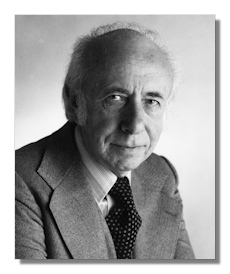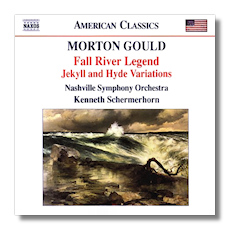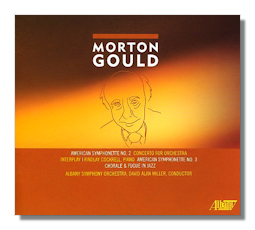
The Internet's Premier Classical Music Source
Related Links
-
Find CDs & Downloads
Amazon - UK - Germany - Canada - France - Japan
ArkivMusic - CD Universe
Find DVDs & Blu-ray
Amazon - UK - Germany - Canada - France - Japan
ArkivMusic-Video Universe
Find Scores & Sheet Music
Sheet Music Plus -
Recommended Links
Site News
Morton Gould

(1913 - 1996)
Composer, conductor, and pianist Morton Gould (December 10, 1913 - February 21, 1996) may have been one of the most gifted musicians since Mendelssohn. He published his first work at age six (titled, appropriately enough, "Just Six"). He studied at what became Juilliard and at New York University. Very quickly, due mainly to the economic necessities of the Great Depression, his musical life split into commercial and classical, often with a fit between the two. In his twenties, he performed on the radio, became a member of the Radio City Music Hall staff, and began to conduct and host radio programs of his own. Later, he also composed scores for television, Broadway, and films and created several "easy-listening" concept albums. He made, as they say, a lovely dollar. However, he also championed Charles Ives and Aaron Copland.
Stokowski and the Philadelphia Orchestra premiered his first symphonic work, Chorale and Fugue in Jazz in 1933. However, much of Gould's output during the Thirties consisted of pieces written for the time constraints of commercial radio. From this part of his catalogue, he had several light-classical hits: American Symphonette #2 (especially the "Pavan" movement, a perky blend of Prokofiev and jazz, 1935), Latin-American Symphonette (1941), and American Salute (variations on "When Johnny Comes Marching Home," 1943), the latter written and scored the evening before its premiere.
Gould's early music consisted of classical takes on jazz and pop influences, but really he could do anything. However, his astonishing professionalism and facility, as well as his inspirations from vernacular sources, caused writers either to ignore him or suspect him of mediocrity and music for the brain-dead. Yet, his speed never got in the way of his music's quality. He was used to writing for radio deadlines, and he could compose directly in full score, both of which strike me as assets, not detriments. He wrote a healthy number of more ambitious works: three symphonies, concerti for violin, piano, viola, Interplay (1945), Fall River Legend (1947), two concerti for tap dancer, Dance Variations for two pianos and orchestra (1953), Derivations for clarinet and band (one of the great classical idiomatic reconstructions of jazz, 1956), Jekyll and Hyde Variations (1957), and Spirituals for Strings (1961). Most of this uses a neoclassical aesthetic. Gould once joked, "That Stravinsky – he's always stealing from me." However, Gould luckily possessed a unique voice, a real rhythmic flair, and a happy ability to make tonal harmonies new again. At its most exuberant, his music gets the body to move.
Around the Sixties, Gould began to feel the influence of Charles Ives, particularly Ives's idea of musical simultaneity. However, he disciplined what could have become aural chaos to his innate sense of elegance. Works in this vein include Venice for double orchestra (1967), Soundings (1969), Burchfield Gallery (1981), and parts of the ballet Audubon (1968-83). Nevertheless, he didn't hesitate to return to his neoclassicism when his invention called for it, as shown by his Columbia, Broadsides (1967), Vivaldi Gallery for string quartet and orchestra (1968), and the Pulitzer-winning Stringmusic (1993).
Like William Schuman, Gould is not nearly so well known as he should be. Part of this stemmed from the rancorous, implacable feud he had with Leonard Bernstein, probably the most influential advocate of American neoclassicism of his time. Gould's music lay a little too close to Bernstein's, and Gould was there first. Effectively, Bernstein denied Gould a New York venue. Gould accordingly recorded in London and Chicago, but he wasn't as effectual. Fortunately, he had a successful career and recording contracts as a conductor, so he disseminated his music in mainly that way. Nevertheless, his music may likely survive him. Other conductors took him up, both before and after his death. Music so attractive, lively, and original is hard to remain indifferent to and, therefore, to kill. ~ Steve Schwartz

Recommended Recordings
 Fall River Legend (Ballet)
Fall River Legend (Ballet)
- Fall River Legend; Jekyll and Hyde Variations/Naxos 8.559242
-
James F. Neal (spoken vocals), Kenneth Schermerhorn/Nashville Symphony Orchestra
- Fall River Legend/Albany Records TROY035-2
-
Brock Peters (spoken vocals), Milton Rosenstock/National Philharmonic Orchestra
- Fall River Legend (Suite); Latin American Symphonette w/ Copland/RCA Victor Living Stereo 82876-61505-2
-
Morton Gould/Morton Gould Orchestra
Symphonettes
- American Symphonettes #2 & 3; Concerto for Orchestra, Interplay, Chorale & Fugue in Jazz/Albany Records TROY1174
-
David Alan Miller/Albany Symphony Orchestra
- Latin American Symphonette; Fall River Legend Suite w/ Copland/RCA Victor Living Stereo 82876-61505-2
-
Morton Gould/Morton Gould Orchestra
- Latin American Symphonette w/ Gershwin/EMI Classics 09996-06691-2
-
Felix Slatkin/Hollywood Bowl Symphony Orchestra















